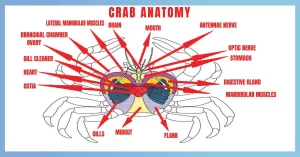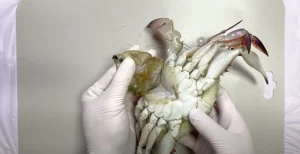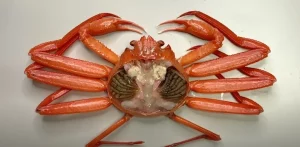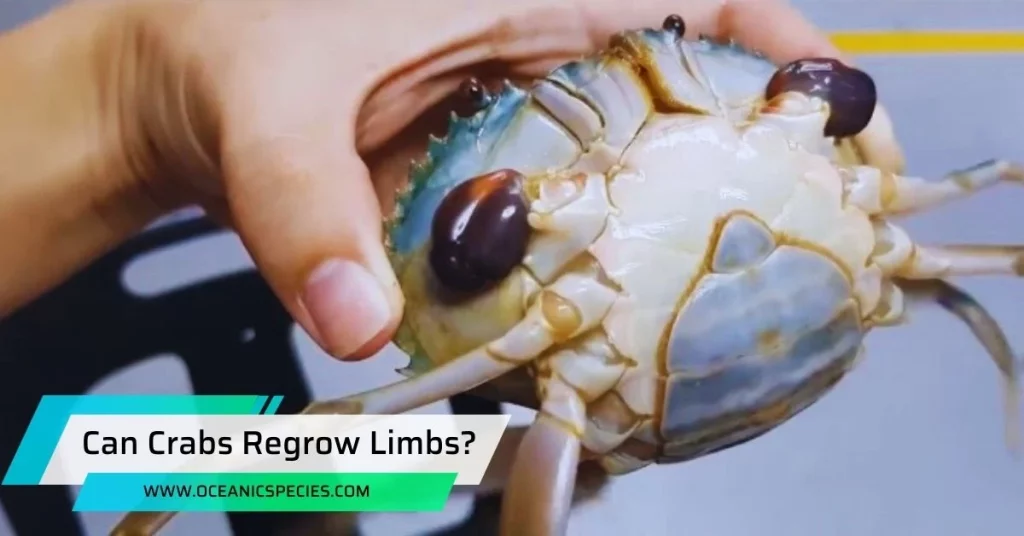Crabs have 10 legs. The front pair of legs has strong, gripping claws on the end, while the remaining eight legs are used for walking.
Crabs are fascinating crustaceans found in oceans, freshwater, and even on land. They belong to the infraorder Brachyura and are characterized by their short projecting “tail” hidden under the thorax. These creatures feature a thick exoskeleton and are known for their distinctive pincers.
With their ten legs, crabs are well-equipped to navigate their surroundings and secure their prey. While most crab species have ten legs, there are exceptions. Some false crabs, like the porcelain crab, have eight legs.
We will explore the various aspects of crabs, including their incredible ability to move and adapt in different environments. Get ready to dive into the fascinating world of crabs and discover some interesting facts along the way.
Understanding Crab Anatomy
Crabs have 10 legs, with the front pair being strong claws used for gripping. The remaining eight legs are used for walking.

Overview Of Crab Anatomy:
Crabs are decapod crustaceans belonging to the infraorder Brachyura. They have a short projecting “tail” that is usually hidden under the thorax. Crabs can be found in all the world’s oceans, freshwater, and even on land.
They are known for their thick exoskeleton, which helps protect their bodies. Unlike other animals, crabs have a unique anatomy, including multiple pairs of legs and specialized limbs.
The Role Of Legs In Crab Locomotion:
Crabs have ten legs in total, with the front pair being their prominent claws. The front claws, also known as chelipeds, are specifically designed for gripping and holding objects, including food.
The remaining eight legs are used for walking and moving around. Legs play a vital role in a crab’s locomotion, allowing them to navigate their environment and find food. Crabs move in a sideways motion, using their legs to scuttle across the ocean floor or the land.
The Unique Structure Of Crab Limbs:
Crab limbs have a distinctive structure that sets them apart from other creatures. Each leg is composed of multiple segments, connected by joints that provide flexibility and movement.
The legs are covered in bristly hairs that aid in sensing their surroundings and detecting vibrations. The end of each leg features small pincers or claws that help crabs with various tasks, such as gathering food or defending themselves.
The structure and function of crab limbs vary depending on the species, allowing them to adapt to their specific habitats.
The Ten Legs Of A Crab
Crabs have 10 legs – four pairs for walking and one pair of pincers or claws. However, some false crab species may have fewer legs, like the porcelain crab with eight legs. Discover more fascinating crab facts here.

Exploring The Ten-Legged Nature Of Crabs:
Crabs are fascinating creatures with ten legs in total, which sets them apart from many other animals. The front pair of legs, also known as chelipeds, are larger and more powerful than the rest.
The chelipeds are equipped with strong, gripping claws that crabs use for various purposes. The remaining eight legs are primarily used for walking and maneuvering.
How The Front Pair Of Legs Differs From The Rest:
The front pair of legs, or chelipeds, are specialized limbs that distinguish crabs from other creatures. These legs are larger and bulkier compared to the rest of the legs, giving crabs their distinctive appearance.
The chelipeds have sharp and sturdy claws at the end, which vary in shape and size depending on the crab species. With their powerful claws, crabs can defend themselves, catch prey, and even use them for communication.
The Specialized Functions Of Each Leg:
The first pair of legs, or chelipeds, serve various functions such as catching food and fighting off predators. The second pair of legs are called the walking legs and are responsible for locomotion and general movement. The third pair of legs are known as the gnathopods and help with feeding and grooming. The remaining five pairs of legs also contribute to locomotion, stability, and balance.
The Evolution Of Crab Limbs
Crabs have 10 legs, with the front pair being strong, gripping claws and the remaining eight used for walking. Some species, like the porcelain crab, may have fewer than ten legs.

Crabs are fascinating creatures with a unique set of limbs that have evolved over time to help them adapt and survive in their environments. In this section, we will explore the evolutionary history of crustacean limbs, how crabs have adapted their limbs for survival, and the diverse range of crab leg shapes and sizes.
The Evolutionary History Of Crustacean Limbs:
Crustaceans, including crabs, have a long history dating back to the Cambrian period, over 500 million years ago. The limbs of crustaceans have evolved from simple extensions of the body to highly specialized and diverse structures.
The evolution of crustacean limbs is closely linked to the development of jointed appendages, which allowed for greater flexibility and range of movement. Over time, crustacean limbs have become specialized for different functions, such as walking, feeding, or reproduction.
How Crabs Adapted Their Limbs For Survival:
Crabs have adapted their limbs in various ways to enhance their chances of survival in their habitats. The front pair of crab legs, known as chelipeds, have evolved into powerful claws used for defense, capturing prey, and manipulation.
Some species of crabs have elongated and slender legs for efficient swimming, while others have flattened legs for crawling or burrowing. Crabs that live in rocky environments often have sharp, spiny legs to help them grip onto surfaces and avoid being swept away by currents.
Some crabs, such as fiddler crabs, have one significantly larger claw, which they use for communication and attracting mates.
An Exploration Of The Diverse Range Of Crab Leg Shapes And Sizes:
Crab legs come in a wide variety of shapes and sizes, depending on the species and their specific needs. Some crabs have long and slender legs, resembling that of a spider, allowing them to move quickly and gracefully.
Other crabs have short and stubby legs, which are excellent for digging burrows and searching for food in the sand. There are also crabs with flattened legs that function as paddles, helping them swim or move through aquatic environments.
The diversity in crab leg shapes and sizes is a result of millions of years of evolution and adaptation to different ecological niches.
Frequently Asked Questions
Do All Crabs Have 10 Legs?
Most crabs have ten legs, with four pairs for walking and one pair of pincers or claws. However, some species may have fewer legs, like the porcelain crab with eight legs.
What Kind Of Crab Has 8 Legs?
Crabs are crustaceans with 10 legs. The front pair has strong claws, while the remaining eight are for walking.
Conclusion
To wrap up, crabs are fascinating creatures with a unique anatomy. They have a total of 10 legs, which include four pairs of walking legs and one pair of pincers or claws. These specialized appendages allow crabs to navigate their environment and protect themselves from potential threats.
While most crabs conform to the 10-legged norm, there are a few exceptions. Some species, such as the porcelain crab, have only eight legs. It’s important to remember that crabs are crustaceans and belong to a diverse group of animals that exhibit variations in their physical characteristics.
Whether they scuttle along the ocean floor or inhabit the sandy shores, crabs have adapted to their environments in remarkable ways. Their ability to regenerate lost appendages further adds to their resilient nature. Next time you come across a crab, take a moment to appreciate its intricate legs and the incredible adaptations that allow it to thrive in its habitat.





